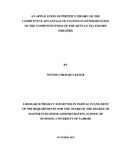| dc.description.abstract | The Tea export industry plays a very crucial role in the Kenyan economy as tea is one of the
main foreign exchange earners. In fact Tea has overtaken tourism to become the country's
number one foreign exchange earner. Although the tea industry has been completely
liberalized, government control exists under the Tea Board of Kenya whose directors are
directly elected by key stakeholders in the industry. As the global environment changes, it is
important that the tea exporting firms assess the changes with a view to enhancing their
competitiveness.
Porter in his theory of competitive advantage points out that there are four primary
determinants of competitiveness of firms; factor conditions, demand conditions, related and
supporting industries, and firm strategy, structure, and rivalry. The objectives of study were
to determine the competitiveness of the Kenya Tea export industry using Porter‟s theory of
the competitive advantage of nations and to establish any other factors other than those
suggested in the theory that could influence the competitiveness of Kenya‟s tea export
industry. Literature review was gathered from various authoritative sources with more
emphasis on more current and relevant literature from renowned authors in strategic
management.
The research design used was a descriptive survey approach which targeted 67 registered tea
exporting companies in Kenya located within the city of Mombasa. The data collection tool
used was a questionnaire with closed and open-ended questions guided by the contents of the
literature review and aimed at achieving the set objectives. The targeted respondents were
the Managing directors of the firms. The results obtained from the questionnaire were first
summarized in a data preparation process and results were analyzed using the descriptive
analysis and use of graphical techniques. Tables were used to show percentages and trends in
the data. In order to measure the spread of the data over the sample population, mean scores
and standard deviations were calculated using the SPSS package.
The study revealed that the tea exporting firms in Kenya apply the Porter‟s theory of
competitive advantage but also considered other factors in enhancing their competitiveness in
the industry. | en |

